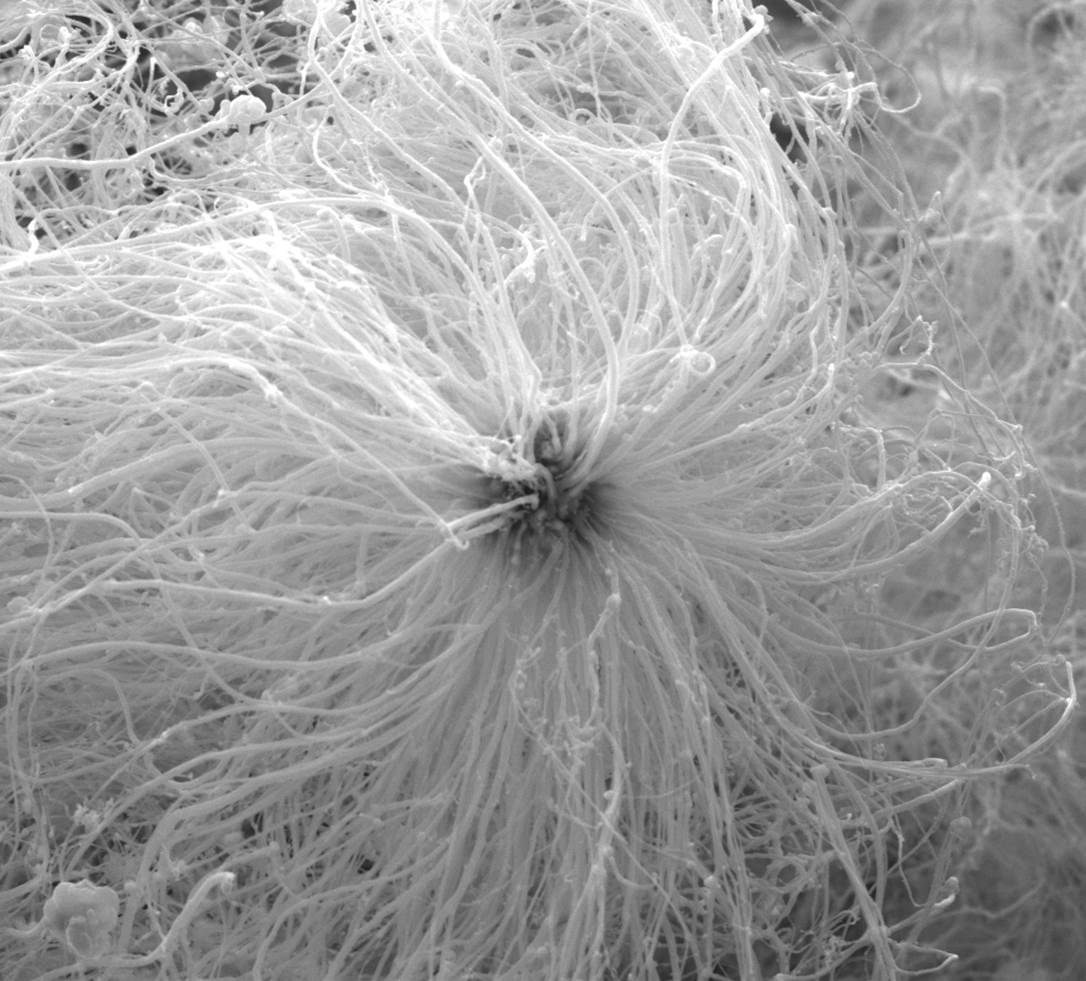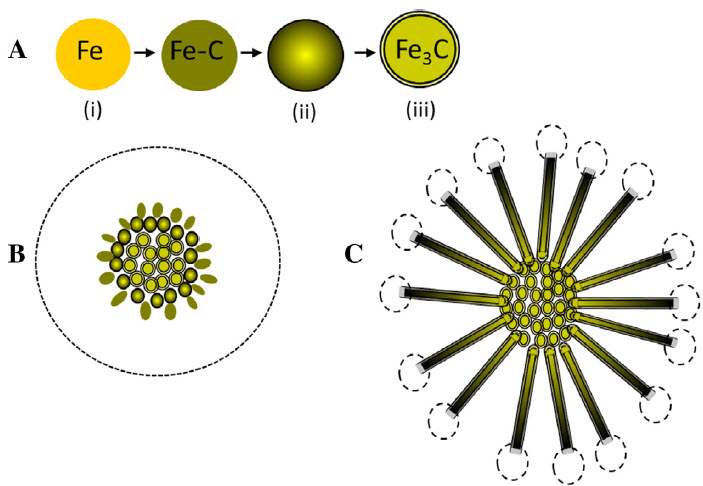Accidental ‘urchin’ nanoparticle discovery could lead to revolution in manufacturing
September 16, 2013

A new Lady Gaga hairdo? No, it’s a scanning electron micrograph of an “urchin” made of self-0rganized multiwall carbon nanotubes emerging from a central particle. (Credit: F. S. Boi, et al./Carbon)
A nanoparticle shaped like a spiky ball, with magnetic properties, has been uncovered in a new method of synthesizing carbon nanotubes by physicists at Queen Mary University of London and the University of Kent.
Described as “sea urchins” because of their characteristic spiny appearance, the particles consist of nanotubes filled with iron, with equal lengths pointing outwards in all directions from a central particle.
The presence of iron and the unusual nanoparticle shape could have potential for a number of applications, such as batteries that can be charged from waste heat, mixing with polymers to make permanent magnets, or as particles for cancer therapies that use heat to kill cancerous cells, the researchers suggest.

Urchin formation: Three-stage urchin formation mechanism in fluctuating metal–carbon vapor. A: Graphite-encapsulated Fe3C particles spontaneously form. B: These spherical structures spontaneously cluster. C: Nanotubes are generated, driven by the diffusion gradient established at the open tip. (Credit: F. S. Boi, et al./Carbon)
How they are formed
The researchers found that the rough surfaces of the reactor were covered in a thick powder of the new nanoparticles and that intentional roughening of the surfaces produced large quantities of the sea urchin nanoparticles.
“The surprising conclusion is that the sea urchin nanoparticles grow in vapor by a mechanism that’s similar to snowflake formation,” said Dr. Mark Baxendale from Queen Mary’s School of Physics and Astronomy.
“Just as moist air flowing over a mountain range produces turbulence which results in a snowfall, the rough surface disrupts a flow to produce a symmetrical and ordered nanoparticle out of chaotic conditions.”
The researchers found that a small fraction of the iron inside the carbon nanotubes was a particular type usually only found in high temperature and pressure conditions.
“We were surprised to see this rare kind of iron inside the nanotubes. While we don’t know much about its behavior, we can see that the presence of this small fraction of iron greatly influences the magnetic properties of the nanoparticle,” he said.
Unpredictable emerging forms in non-equilibrium condition
“Manufacturing processes are usually done in equilibrium conditions (that is, in a steady state) because the outcome is predictable and manufacturing needs predictability and reproducibility,” Baxendale explained to KurzweilAI .
“The new method exploits non-equilibrium conditions, so the outcome cannot be predicted — because we do not have very much knowledge about chemical reactions in non-equilibrium conditions — but is, nevertheless, reproducible; that means we can make large amounts of the stuff.
“This is because the particles are grown at the boundary between equilibrium and non-equilibrium conditions. We contend that anything grown in these conditions will be ordered and reproducible but could be very different from the products grown from the equivalent chemical feedstock in equilibrium conditions. The sea urchin nanoparticles are just one example — there is no fundamental reason why the method cannot be applied to other chemical systems.
A grand challenge: nanoscale design
“The UK EPSRC research council Grand Challenge for Physics for the next 20–40 years includes ‘Nanoscale Design of Functional Materials.’ The systematic design and construction of materials and devices based on structure at the nanoscale is a major challenge. The ultimate aim would be to be able to dial up a desired property using new principles rather than proceeding by trial and error, and to assemble targets cheaply in large quantities.
“Realization of this challenge will advance technologies in a wide range of fields such as healthcare, sustainable materials, information handling, energy harvesting and storage.”
The research was supported by the South East Physics Network.